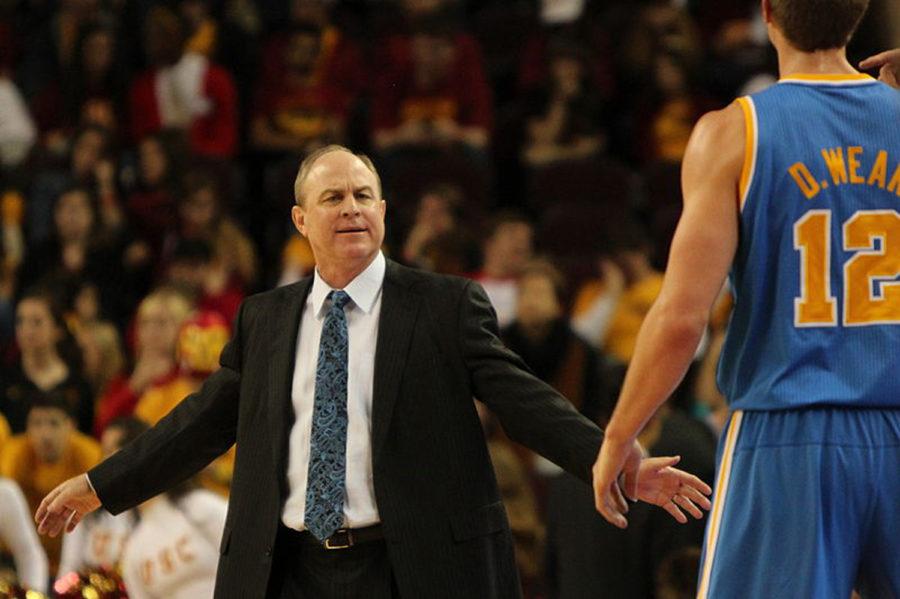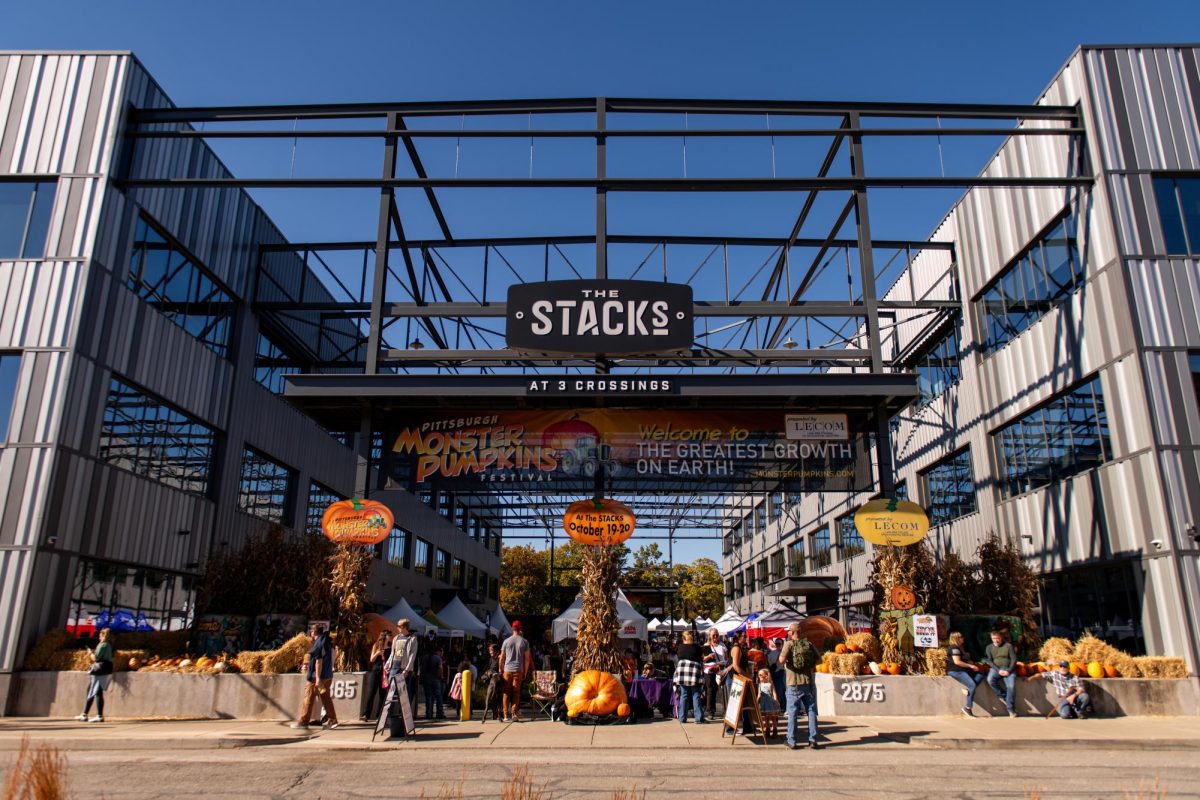Highs and lows of Pitt’s time in the tournament
Via Neon Tommy | Wikimedia Commons
Ben Howland took over as Pitt’s Men’s Basketball head coach in 1999 and built the Panthers into a contending team on the national stage.
March 18, 2019
For the better part of the 21st century, March has been a time for Pitt basketball fans to look forward to the NCAA Division I Men’s Basketball Tournament with a mixture of high hopes and preparative disappointment. The Panthers made the Big Dance 13 out of 15 times from 2002 to 2016, an unprecedented run of success started by former head coach Ben Howland and continued under Jamie Dixon.
But the Panthers have failed to make the tournament for three straight seasons since Dixon left in 2016, leaving Panther fans twiddling their thumbs and sitting idly by as another Pitt-less March Madness unfolds. With no Pitt basketball to look forward to, we can only look back — so let’s take a trip down memory lane and reminisce on the highs and lows of Panther tournament yore.
Final Four appearance (sort of)
The first semblance of a national college basketball tournament popped up in 1939, when Ohio State head coach Harold Olsen came up with the idea for a single-elimination bracket to determine a champion. However, it was a far cry from the 68-team pool we know today — only eight teams made the tournament for the first 11 years of its existence
The Panthers, coached by legendary head coach and Naismith Hall of Fame inductee Doc Carlson, made the tournament while it was still in its infancy in 1941. They took down the UNC Tar Heels in the first round, 26-20, thus advancing to the “Final Four,” where they lost to the eventual national champion Wisconsin Badgers 36-30.
Sure, this lone Final Four appearance stands out as mostly a formality considering it only took one win to get there. But give this Pitt team some props for making this highly selective tournament at all. The Panthers proceeded to miss the tourney entirely for a program-record 15 straight seasons afterward, making this accomplishment appear all the more impressive.
First Sweet 16 under Ben Howland
When the tournament expanded to its modern 64-team format in 1985, the Panthers settled into their role as a perennially decent team under head coach Paul Evans. You could count on them to make the tournament, but never advance past the second round. Then, Ralph Willard took over in 1994, and the program took a nosedive into mediocrity, failing to make the tournament in each of his five seasons.
Ben Howland took over in 1999 and slowly but surely built the Panthers into a contending team, going 13-15 then 19-14 before breaking through with a 29-6 record in his third year. With junior guard Brandin Knight leading the way, the third-seeded Panthers stormed their way to the Sweet 16 before finally falling to Kent State in overtime, 78-73.
This appearance signified to the college basketball world that Pitt would be a contender on the national stage for years to come, and it jump-started a run of two consecutive Sweet 16 appearances that followed. Howland left Pitt for greener Los Angeles pastures in 2003, but the success he built continued under his protege Jamie Dixon.
Scottie Reynolds at the buzzer
The year was 2009, and the Panthers entered March Madness with the fearsome trio of Sam Young, DeJuan Blair and Levance Fields. This should technically qualify as a high moment for the program. After all, it was Pitt’s first ever No. 1 seed in the tournament, and they finally made it past the Sweet 16 for the first time in modern tournament history.
But as any Pitt fan will tell you, there’s a reason this season is often regarded with a sense of sorrow rather than pride. Two words — Scottie Reynolds.
After cruising through their first three games, the Panthers faced third-seeded Villanova with a trip to the coveted Final Four on the line. The two teams battled evenly for 39 minutes and 54.5 seconds, and Fields sunk two clutch free throws to tie the game at 76 with 5.5 seconds remaining.
The rest, as they say, is history. Villanova inbounded the ball to a player near midcourt, who immediately dished the ball off to junior guard Scottie Reynolds streaking down the sideline. Reynolds pried his way into the paint and put forth a contested floater that sunk gently through the net with just 0.5 seconds left on the clock, crushing the hearts of Pitt fans everywhere.
#TBT to when Scottie Reynolds broke Pitt’s heart. pic.twitter.com/KGXEZ7okNh
— NCAA March Madness (@marchmadness) December 8, 2016
Young and Fields graduated in the spring, and Blair declared for the NBA in the offseason, making this their final college appearance. Making the Elite Eight is a feat in itself, but Pitt’s most talented team ever deserved a better send-off.
Second-round loss to Butler
The Panthers found themselves with championship aspirations once again two seasons later, snagging a No. 1 seed heading into the 2011 NCAA Tournament with a 28-6 overall record. Pitt fielded a supremely well-balanced team led by sharpshooting point guard Ashton Gibbs, although the Panthers entered the tournament on a shaky note after being on the receiving end of a soul-crushing Kemba Walker stepback in the Big East Tournament.
Kemba Walker did THAT 8 years ago today and will forever be known as ‘Cardiac Kemba’ because of it ?
(via @espn)pic.twitter.com/Dg2uAY7NdV
— Yahoo Sports (@YahooSports) March 10, 2019
That upset loss to eventual national champion UConn should’ve been a sign that fate did not favor the Panthers. But they went ahead and played anyway, meeting the eighth-seeded Butler Bulldogs in the second round of the tourney. What followed was one of the more bizarre endings ever seen in a basketball game.
Following a back-and-forth battle throughout, Butler took a 70-69 lead on a layup with 2.2 seconds left, dealing what should’ve been a fatal blow to the Panthers. But Butler guard Shelvin Mack pressured Pitt guard Gilbert Brown a little too close on the inbound, committing an absent-minded foul that sent Brown to the foul line with a chance to win the game.
With 1.4 seconds on the clock, Brown made the first free throw to tie but couldn’t convert on the second one to take the lead. The ball fell into the hands of Butler forward Matt Howard, and Pitt junior Nasir Robinson inexplicably fouled him with 0.8 seconds left. Howard stepped to the line and made the game-winning free throw to put Butler up for good, 71-70.
Certain singular events often outweigh entire careers, and unfortunately for Robinson, he’s remembered as the guy who made the mistake that cost Pitt yet another Final Four opportunity. Butler and UConn — the last two teams to beat Pitt — would meet in the national championship, embodying the kind of tough luck the Panthers have experienced throughout their tournament history.
CBI National Champions
Don’t let anyone ever tell you that Pitt hasn’t won it all. The 2012 Panthers (17-16 overall, 5-13 Big East), led by the returning senior duo of Gibbs and, ironically, Nasir Robinson, may not have played well enough to qualify for the Big Dance (NCAA Tournament) or even the Average Dance (NIT Tournament). Instead, Pitt had to settle for the Tertiary Dance — the College Basketball Invitational.
And by golly, the Panthers stormed through the 16-team bracket, smoking Wofford and Princeton before meeting Butler once again with a trip to the championship series on the line. Pitt avenged its embarrassing loss from the prior season, besting the Bulldogs 68-62 in overtime. Catharsis!
Pitt met up with Washington State — one year removed from now NBA superstar Klay Thompson’s graduation — in the best-of-three title series. The Cougars stole the first game at their place, 67-66, before Pitt, playing without Gibbs after he suffered an ankle injury, rose to the occasion and snagged the next two at the Pete, 57-53 and 71-65, to win it all, thus earning the school’s only “national championship” ever — albeit in an admittedly sort of sad little way. Just be grateful that we won something.



